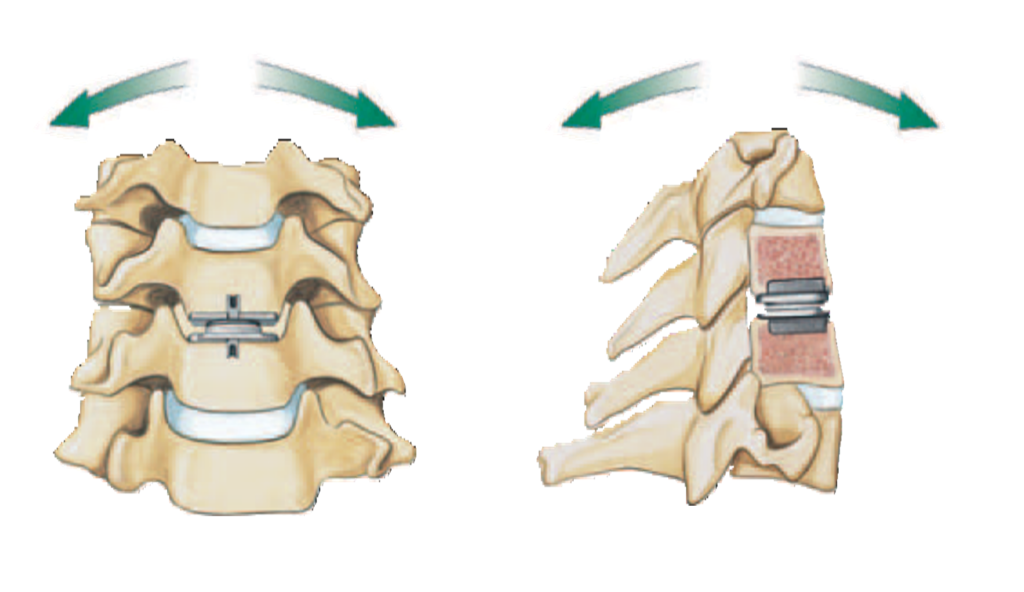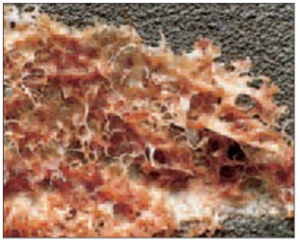prodisc C Total Disc Replacement – An Alternative to Cervical Fusion
Neck and Cervical Spine Anatomy
The vertebral bodies encase the spinal cord to provide protection. When stacked on top of each other, they form the spinal column which provides stability for the head and upper body. The spinal cord and the nerve exits are located within the spinal canal.
The intervertebral discs are located between the vertebral bodies. These discs cushion shock forces, acting as “shock absorbers”. The discs in conjunction with the vertebral joints facilitate motion by turning, stretching and bending of the neck.

Degenerative changes of the spine
Degenerative changes of the spine occur from natural aging associated with pathological changes of the vertebral bodies, intervertebral discs, ligaments and vertebral joints. These changes can greatly limit both the mobility and stability of the spine.
The stability of the spine can also be compromised by unnatural weight distribution caused by a hereditary abnormality, or a lack of movement associated with a sedentary lifestyle. Any previous operation or trauma to the spinal column can also cause a loss of stability.
Any form of instability can progress to become a pain generator.
Herniated Discs
The described degenerative changes or trauma can cause tears in the intervertebral disc. The escape of the nucleus (or soft interior) of the intervertebral disc outward through these tears may cause a disc herniation.
The disc herniation can impinge on the nerves and depending on the location can cause pain in the neck, arms and shoulders. In the extreme case, it can cause paralysis.
prodisc C Total Disc Replacement
The treatment goal of the prodisc C Total Disc Replacement is to restore the normal dynamic function of the spine and to significantly reduce pain.
The function of the spine is restored through the mechanism of action of the device. Pain reduction is achieved through the re-establishment of the disc height, and maintained by the prosthesis. The increase in height and the elimination of the herniated disc “opens” constricted nerve paths and the vertebral joints are restored to their physiological position.
Prior to the development of artificial discs the only surgical option was a fusion, in which adjacent vertebral bodies are “fused together” permanently using implants, bone chips and/or cages. The goal of prodisc C is to maintain mobility at the affected intervertebral disc and to reduce the extra loading on the adjacent intervertebral discs.

prodisc C Goals
Maintain Spinal Balance and Motion
Degenerative disc disease can destabilize segments over time. In addition, performing the surgical discectomy is inherently destabilizing, as it involves the removal of the Anterior Longitudinal Ligament, the disc, and often, the Posterior Longitudinal Ligament. In the absence of these restricting structures, it isimportant for a disc replacement to have constraints in order to protect the facet joints.
In order to provide constraint, the prodisc mechanism of action enables movement with a fixed center of motion, enabling A/P translation only with flexion / extension.
Controlled and Predictable Motion
- Allows a normal range of motion while providing segmental stability through controlled translation.
- Highly conforming surfaces of the superior endplate and UHMWPE inlay prevent the endplates from translating independently
- Translation is provided by rotation of the superior endplate around the ball on the inferior endplate.

Range of Motion
- The prodisc C is designed to allow for a normal range of motion in flexion /extension, lateral bending, and axial rotation.
* L5, LD5, XL5 and XLD5 sizes allow 17.5° in flexion / extension and lateral bending.

Decelerate Adjacent Level Reoperations
The historical treatment for degenerative disc disease is to conduct an ACDF and fuse the joint. However, immobilizing a segment of the spine has been shown to increase the rate of adjacent-level degeneration. By enabling motion, prodisc is intended to decelerate adjacent level degeneration. A paper published on the results with the US IDE PMA clinical study on prodisc showed that, at seven years follow-up, patients had four times fewer reoperations of adjacent segments, compared to patients that received an ACDF.
Range of Motion
- The prodisc C is designed to allow for a normal range of motion in flexion /extension, lateral bending, and axial rotation.1
- Long-term prospective randomized multi-center evidence illustrates that patients retained range of motion of 8.12° for 7 years.1
- Fusion patients from the study had a range of motion of 0.66°.1
1 Janssen ME, et al, ProDisc-C Total Disc Replacement Versus ACDF for Single-Level Symptomatic Cervical Disc Disease, JBJS, 2015, 97:1738-47.

 Accelerate the Resumption of Activities of Daily Living
Accelerate the Resumption of Activities of Daily Living
The operative procedure to conduct a discectomy can be invasive and require recuperation. Special care has been taken to design the technique and instrumentation to minimize the recovery associated with the procedure. A review of nearly 7,000 patients in the Blue Health Intelligence Claims Database showed that patients who received a prodisc C experienced significantly shorter length of hospital stays compared to patients who received an ACDF.2
Patented Midline Keel
- prodisc is intended to provide immediate stability by self through the design of the keel.
- Possibly due to this design element, a study on military personnel determined that receiving a prodisc C vs. ACDF led to a 60% shorter return time to active duty.
2 MCRA, MCRA break-down of Blue Health Intelligence Data: ACDF vs. Cervical Disc Arthroplasty Outcomes, 2012.Results on file at DePuy Synthes Spine. Data available upon request.
prodisc C Design
The prodisc C intervertebral disc prosthesis consists of two cobalt chrome plates with a titanium coating that allows for bony ingrowth onto the prosthesis. A polyethylene core located between the plates guarantees the mobility in the segment (ball and socket joint principle). All of these materials are clinically proven to be tolerated very well by the body. This design prevents overloading of the adjacent intervertebral discs, as can occur after traditional spinal fusion.
Different sizes of the individual components are available to best fit with your anatomy.
 Anchorage of the prosthesis
Anchorage of the prosthesis
To achieve short-term, primary stability directly after the operation, the prodisc C intervertebral prosthesis is equipped with a keel which is anchored directly on the vertebral body. The necessary stability is thus guaranteed immediately upon implantation.
In addition, the entire surface is coated with a highly porous pure titanium layer which facilitates the growth of bone on the metal components due to its extremely rough and porous surface.
prodisc C Clinical History
 prodisc C has a long clinical history (15+ years) and has been widely used throughout the world. The prodisc line of total disc replacement (TDR) is the most widely studied TDR, with over 400 peer-reviewed published studies, reporting on over 13,000 patients. The first implantation of a prodisc C took place in 2001—with US PMA approval following in 2007. The prodisc design has been validated with over 125,000 device implantations and a reported reoperation rate of less than 1%.
prodisc C has a long clinical history (15+ years) and has been widely used throughout the world. The prodisc line of total disc replacement (TDR) is the most widely studied TDR, with over 400 peer-reviewed published studies, reporting on over 13,000 patients. The first implantation of a prodisc C took place in 2001—with US PMA approval following in 2007. The prodisc design has been validated with over 125,000 device implantations and a reported reoperation rate of less than 1%.
prodisc is distributed by:
CENTINEL SPINE, LLC
900 Airport Road, Suite 3B West Chester, PA 19380 Tel: 484.887.8810
Fax: 800.493.0966
Centinel Spine® and prodisc are registered trademarks of Centinel Spine, LLC
prodisc is distributed by:
CENTINEL SPINE, LLC
900 Airport Road, Suite 3B West Chester, PA 19380 Tel: 484.887.8810
Fax: 800.493.0966
[email protected] www.centinelspine.com
MKT-0079 1/19


